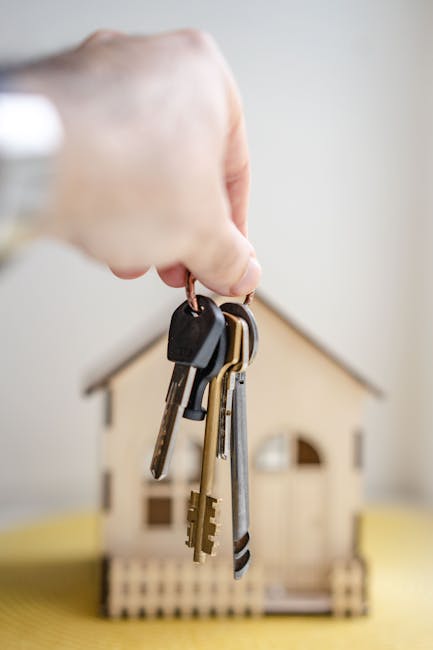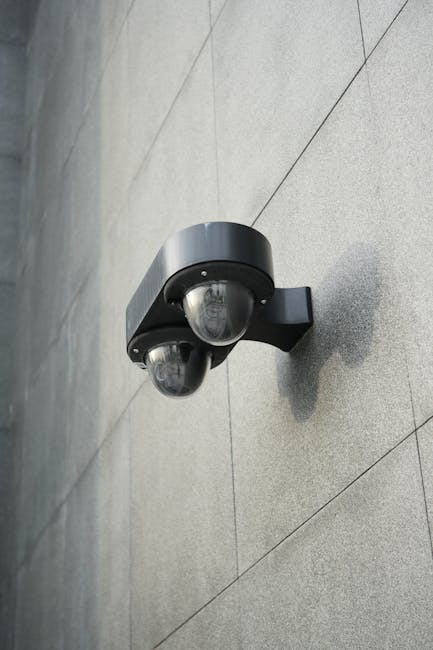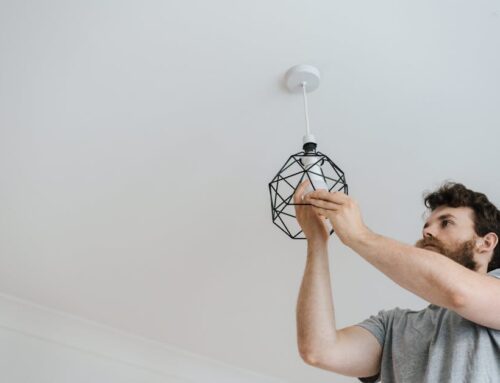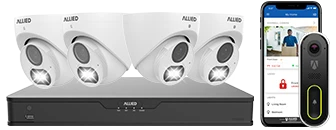Introduction to Home Alarm Systems
Home alarm systems have become an essential component in ensuring the safety and security of residences. As technology progresses, these systems have evolved from basic models to sophisticated, feature-rich solutions that provide comprehensive protection. Understanding the importance of home alarm systems and the advancements in their technology can help homeowners make informed decisions to secure their properties effectively.
The primary function of home alarm systems is to detect unauthorized entry and alert the homeowner or authorities. Modern systems achieve this through a combination of sensors, cameras, and control panels. These components work harmoniously to provide real-time alerts and deter potential intruders.
Beyond mere detection and alert capabilities, contemporary home alarm systems offer a variety of features that enhance overall security. For instance, integration with smart home technologies allows for remote access and control, giving homeowners the ability to monitor and manage their security systems from anywhere using smartphones or other connected devices. This undoubtedly adds a layer of convenience and ensures peace of mind.
Moreover, the alarm systems today can be tailored to meet specific needs. Whether a homeowner requires basic intrusion detection or a comprehensive setup that includes fire detection, carbon monoxide alerts, and flood sensors, there is a solution available. These customizations ensure that every aspect of residential safety is addressed comprehensively.
The market offers a wide array of home alarm systems, each designed to cater to different needs and preferences. From simple DIY kits that are easy to install to professionally monitored systems that offer round-the-clock surveillance, the options are plentiful. Recognizing the various types and understanding their features can significantly enhance the ability to choose the right system.
Additionally, many modern home alarm systems come equipped with advanced technologies such as artificial intelligence (AI) and machine learning. These technologies enable the systems to learn a household’s patterns and identify unusual activities, further enhancing the system’s ability to respond to potential threats effectively.
In conclusion, the evolution of home alarm systems embodies a blend of traditional security principles with cutting-edge technology. Homeowners who remain informed about these advancements and understand the comprehensive capabilities of contemporary alarm systems can make strategic decisions to safeguard their homes efficiently.
Key Components of Home Alarm Systems
When evaluating home alarm systems, understanding the key components is essential for making an informed decision. A robust system typically encompasses several integral parts, each playing a crucial role in ensuring comprehensive security. These components are designed to work together to detect, alert, and prevent potential break-ins and other emergencies.
Control Panel: The control panel acts as the brain of the alarm system. It connects and communicates with the various sensors and detectors installed throughout the home. Modern control panels often feature touchscreens and can be programmed to alert homeowners and monitoring services in the event of an emergency. They can also be integrated with mobile apps for remote access.
Keypad: The keypad is the primary interface for arming and disarming the alarm system. It is typically mounted near the main entrance of the home, allowing easy access for the homeowner. Many keypads now include touch screens or can be controlled via a smartphone app for added convenience.
Security Sensors: Security sensors are crucial in detecting unauthorized entry. They include door and window sensors that trigger the alarm when a breach is detected. These sensors can be wired or wireless and should be strategically placed to cover all possible points of entry.
Motion Detectors: Motion detectors use infrared or microwave technology to sense movement within the home. When movement is detected in an armed area, the alarm is triggered. These devices are typically placed in high-traffic areas and are sensitive enough to differentiate between intruders and pets.
Glass Break Detectors: Specifically designed to recognize the sound frequency of breaking glass, these detectors enhance security by providing an additional layer of protection to windows and glass doors. They are essential for homes with large glass areas or when additional perimeter security is required.
Alarm Siren: A loud alarm siren is a key deterrent for intruders. Upon activation, it emits a high-decibel sound designed to scare off the intruder and alert the homeowner and neighbors. The siren can be internal or external, with the latter being beneficial for alerting those outside the home as well.
Communication Modules: Modern alarm systems often include communication modules such as cellular, Wi-Fi, or hardwired connections. These modules are responsible for sending alerts to homeowners and monitoring services. A combination of these methods ensures redundancy, so alerts are reliably sent even if one method fails.
Backup Battery: In the event of a power outage, a backup battery ensures that the alarm system remains operational. This component is essential for maintaining security during power failures and should provide at least several hours of operation.
Remote Access: Many contemporary alarm systems offer remote access through mobile apps. This feature allows homeowners to monitor the system, receive alerts, and control the system remotely, providing greater peace of mind and flexibility.
By understanding these key components, homeowners can better evaluate which home alarm system will meet their specific security needs. A system with all these elements, working in concert, provides robust protection against potential threats, ensuring a safer living environment.
Security Sensors and Detectors
Security sensors and detectors form the backbone of any effective home alarm system. These devices are responsible for identifying potential security breaches and triggering alarms to alert homeowners and monitoring services. Various types of sensors and detectors offer distinct functionalities, enhancing the overall security framework of a residence.
One of the most common types of sensors used in home alarm systems is the door and window sensor. These sensors typically consist of two parts: one attached to the door or window itself and the other to the frame. When the door or window is opened while the system is armed, the two parts become separated, triggering the alarm.
Another essential type of detector is the motion sensor. These devices can detect movement within a certain range, using technologies such as passive infrared (PIR), microwave, or ultrasonic waves. According to a study by the International Association of Chiefs of Police, PIR sensors are the most widely used because they are less prone to false alarms from pets or small animals.
Home alarm systems also often include glass break detectors. These sensors can recognize the sound frequency of breaking glass, a common method of entry for intruders. Brands like Honeywell and ADT have developed advanced glass break sensors that offer high accuracy in distinguishing between breaking glass and other similar sounds.
Another critical component is the environmental sensor. These sensors go beyond intrusion detection and can monitor for hazards like smoke, carbon monoxide, water leaks, and extreme temperature changes. Companies such as Nest and First Alert provide combination detectors that integrate multiple environmental monitoring capabilities in a single device, enhancing safety and simplifying installation.
The strategic placement of sensors and detectors is vital for optimal security coverage. Experts from Security.org suggest installing motion sensors in high-traffic areas, door and window sensors on all accessible entry points, and glass break detectors in rooms with large windows or sliding doors. This layered approach ensures comprehensive monitoring and minimizes vulnerabilities.
Advanced home alarm systems may also feature video detectors. These combine traditional motion sensing with video verification, allowing users and monitoring services to visually confirm an intrusion. This dual verification can significantly reduce false alarms and improve response times. Brands like Ring and SimpliSafe offer integrated video detection solutions that provide live video feeds and recorded clips.
In conclusion, security sensors and detectors are crucial for the effectiveness and reliability of home alarm systems. By combining different types of sensors and placing them strategically, homeowners can achieve robust protection against various security threats. Furthermore, advancements in sensor technology continue to enhance the precision and functionality of these essential components, making modern home alarm systems more efficient and user-friendly.
Monitoring and Response Services
When selecting a home alarm system, one of the crucial aspects to consider is the Monitoring and Response Services. Monitoring services play a vital role in ensuring that any security breach is promptly addressed. Different providers offer various levels of monitoring services, and understanding these can help in choosing the most appropriate system for your needs.
Types of Monitoring Services
There are primarily three types of monitoring services available:
- Professional Monitoring: This service involves a dedicated team of security professionals monitoring your alarm system 24/7. When an alarm is triggered, they reach out to you and, if necessary, dispatch emergency services. This is considered the most reliable form of monitoring as it ensures that trained personnel handle any emergency.
- Self-Monitoring: In self-monitoring, the system sends alerts directly to your smartphone or other device, and you are responsible for contacting the authorities if needed. While this option can be more cost-effective, it requires you to be always available to respond to alerts.
- Hybrid Monitoring: This combines elements of professional and self-monitoring. It allows you to monitor notifications on your own while still having the option to call for professional intervention when necessary. This provides a balance between cost and security.
Response Time and Protocols
The response time of a monitoring service is a critical factor. Fast response times can significantly reduce the consequences of a security breach. The average response time for professional monitoring services usually ranges from a few seconds to a minute, depending on the provider and the type of alert. Protocols typically include verifying a triggered alarm through contact with the homeowner and, if necessary, dispatching emergency services. Some advanced systems can also use video verification to quickly ascertain the nature of an alert.
Backup and Redundancy
Another important feature to consider is the redundancy and backup systems in place. In case of a power outage or internet failure, a reliable home alarm system should have alternative communication methods such as cellular backup. This ensures
that the monitoring service remains operational even if the primary communication line is disrupted. Many top-tier providers include cellular backup in their monitoring plans.
Customer Service and Support
Finally, the quality of customer service and technical support provided by the monitoring service is essential. Continuous support can help troubleshoot issues quickly and maintain the functionality of the alarm system. Many reputable monitoring service providers offer 24/7 customer support to assist with both routine queries and emergencies.
In summary, the right monitoring and response service for a home alarm system depends on individual security needs and budget. Professional monitoring offers the highest level of security, while self-monitoring and hybrid models provide flexibility and can be more cost-effective. Ensuring fast response times, adequate backup measures, and reliable customer support are key aspects to look for in effective monitoring services.
User-Friendly Interfaces and Controls
One of the essential features to look for in home alarm systems is the user-friendly interface and controls. A well-designed interface allows homeowners to easily manage and operate their security system without extensive technical knowledge.
Intuitive Mobile Apps
Most modern home alarm systems come with companion mobile apps that offer remote access and control. These apps typically provide functionalities such as arming and disarming the system, receiving real-time alerts, and viewing live camera feeds. Look for apps that offer a clean, intuitive design and user-friendly navigation.
Touchscreen Panels
Touchscreen control panels often serve as the central hub of a home alarm system. These panels should feature an easy-to-read display, straightforward menu navigation, and quick access to emergency services. Users should be able to customize settings and view system status with minimal steps.
Voice Control Integration
Voice recognition technology can significantly enhance the usability of an alarm system. Some systems integrate with popular voice assistants like Amazon Alexa or Google Assistant, allowing for voice commands to control various functions such as system arming, disarming, and checking status updates. Ensure the system is compatible with your preferred voice assistant for seamless integration.
Customizability
Another crucial aspect of user-friendly interfaces is the ability to customize notifications and settings. Users should be able to set preferences for how and when they receive alerts (e.g., text, email, push notifications). Customizable settings also allow homeowners to adjust sensor sensitivity, set arming schedules, and create user-specific access codes.
Comprehensive User Guides and Support
A user-friendly interface is also supported by detailed user manuals, extensive FAQs, and responsive customer support. These resources ensure that users can troubleshoot issues and fully understand the system’s capabilities. Good technical support can make a significant difference in effectively managing and operating the alarm system.
Ease of Installation and Setup
Finally, a user-friendly home alarm system should offer straightforward installation and setup processes. Many systems are now designed for DIY installation with clear instructions, reducing the need for professional installation services. Quick-start guides and easy-to-follow installation videos are beneficial features to consider.
In conclusion, considering the user-friendly interfaces and controls of home alarm systems is crucial for a stress-free experience. Investing in a system that is intuitive, customizable, and well-supported can greatly enhance home security management.
Integration with Smart Home Technologies
Home alarm systems today are increasingly integrating with smart home technologies, enhancing their functionality and making them more user-friendly. Smart home integration allows users to connect their alarm systems with various smart devices and platforms, providing a seamless and interconnected home security experience.
One of the key advantages of integrating a home alarm system with smart home technologies is the ability to control and monitor the system remotely. Most modern alarm systems offer mobile apps that allow you to arm or disarm the system, receive alerts, and monitor live video feeds from your smartphone or tablet, no matter where you are.
Another critical aspect of integration is the compatibility with other smart devices. Many alarm systems can be connected with smart locks, video doorbells, security cameras, and lighting systems. This means, for instance, when an alarm is triggered, the lights in your home could turn on automatically, or a smart lock could lock all doors, providing an extra layer of security.
Voice control is also an essential feature provided by integration with smart home assistants like Amazon Alexa, Google Assistant, and Apple HomeKit. This allows users to control their alarm system using simple voice commands, making it more convenient to operate.
Integration goes beyond convenience; it also enhances the overall functionality of the alarm system. For example, by connecting the alarm system with environmental sensors such as smoke detectors, carbon monoxide detectors, and water leak sensors, users can receive comprehensive alerts that go beyond traditional burglary notifications.
Moreover, many smart home integrated alarm systems provide automation capabilities. Users can set up automation rules, such as turning on security cameras or activating the alarm when motion is detected at specific times or under certain conditions. This level of automation ensures that the home remains secure without requiring constant manual intervention.
When choosing a home alarm system, it is imperative to consider how well it integrates with your existing smart home devices and platforms. Compatibility with popular smart home ecosystems like Amazon Alexa, Google Assistant, and Apple HomeKit ensures that the system can work seamlessly with various smart gadgets, providing a robust and cohesive security solution.
In conclusion, integration with smart home technologies significantly enhances the functionality and usability of home alarm systems. By enabling remote control, interoperability with other smart devices, voice control, environmental monitoring, and automation, these systems provide a more secure, efficient, and user-friendly home security environment.
Cost and Warranty Considerations
When selecting a home alarm system, two critical factors to consider are the cost and warranty. Understanding these elements can help you make an informed decision that fits both your budget and long-term security needs.
Cost Considerations
The cost of home alarm systems can vary significantly based on features, brand, and level of service. Below are some key components that influence the overall cost:
- Initial Purchase Price: This is the upfront cost of acquiring the equipment, including sensors, control panels, and cameras.
- Installation Fees: These are costs associated with professional installation, which may vary depending on the complexity of the system.
- Monthly Monitoring Fees: If you opt for professional monitoring services, this will be a recurring monthly expense. The price generally ranges from $10
to $60 per month. - Maintenance and Repair Costs: Consider potential future expenses for maintaining and repairing the system.
Here is a comparative table illustrating typical costs associated with home alarm systems:
| Cost Component | Typical Range |
|---|---|
| Initial Purchase Price | $100 – $1,500 |
| Installation Fees | $0 – $200 |
| Monthly Monitoring Fees | $10 – $60 |
| Maintenance and Repair Costs | Varies based on system and provider |
Warranty Considerations
Warranty is another essential factor when evaluating home alarm systems. A robust warranty can offer peace of mind and reduce long-term costs. Below are important warranty aspects to consider:
- Duration: Warranties can range from one year to lifetime coverage. Make sure to understand the length and terms of the warranty.
- Coverage: Check what components are covered under the warranty. Typically, this includes the main control panel, sensors, and cameras.
- Exclusions: Be aware of exclusions that might render the warranty void, such as improper installation or tampering with the system.
- Service Terms: Understand the process for making warranty claims. Some providers may offer quick replacement services, while others might require the equipment to be sent in for repair.
Most reputable alarm system providers offer a minimum one-year warranty, with many extending up to three years or more for certain components. Always read the fine print to ensure you fully understand the warranty terms before making a purchase.
In conclusion, careful consideration of both cost and warranty can significantly impact your overall satisfaction and financial commitment when choosing a home alarm system. Make sure to evaluate both these aspects in detail to ensure you select the best option for your needs.













